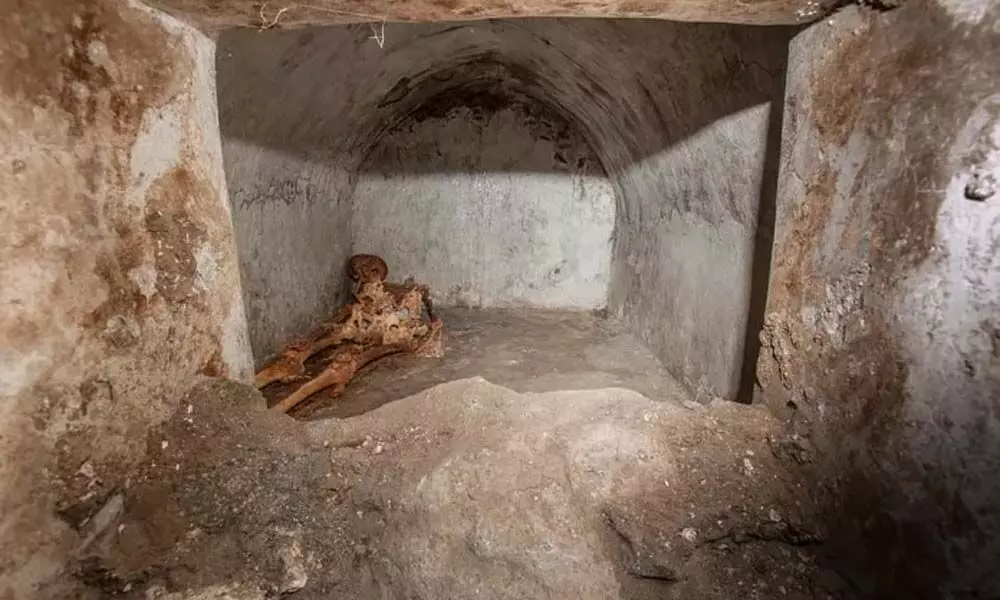Archaeologists Discover Magnificently Maintained Mummy In Ancient Pompeii

The deceased was a man named Marcus Venerius Secundio, who was in his 60s when he died.
- A tomb outside of Pompeii, created before the famous eruption that buried the town in ash, has been unearthed with the partially mummified remains of an urbane Pompeii citizen.
- The deceased was a man named Marcus Venerius Secundio, who was in his 60s when he died.
A tomb outside of Pompeii, created before the famous eruption that buried the town in ash, has been unearthed with the partially mummified remains of an urbane Pompeii citizen.
The deceased was a man named Marcus Venerius Secundio, who was in his 60s when he died and had been enslaved at one point, according to the inscriptions on the tomb. Secundio afterwards became a wealthy priest who performed Latin and Greek ceremonies following his release.
The first direct evidence of Greek performances in the Italian city is a tomb inscription referring to these Greek ceremonies.
In a statement, Gabriel Zuchtriegel, director of the Archaeological Park of Pompeii, said that concerts in Greek were organised is evidence of the active and open cultural milieu which characterised ancient Pompeii.
Marcus Venerius Secundio's mummification, seen up close. Close-cropped hair and an ear can still be seen on the head, despite the fact that the body is approximately 2,000 years old. The remains have been transferred to a lab so that researchers can determine whether the mummification was done on purpose.
Secundio's ashes are interred in a rectangular stone tomb that was formerly painted with representations of green vegetation on a blue backdrop; vestiges of the paint may still be seen on the tomb's outside walls. The partially mummified body was hidden away in a secluded alcove with an arched ceiling in the tomb. On the skull, close-cropped hair and an ear may still be seen.
From Secundio's grave, archaeologists discovered fabric shreds and two glass vials known as 'unguentaria.' Unguentaria can be found in Roman and Greek cemeteries, where they may have stored oils or scents for graveside ceremonies.
Two burial urns were also discovered in the tomb, one of which was a lovely blue-glass urn that belonged to a woman named Novia Amabilis. According to archaeologists, cremation was the most frequent form of burial for Pompeians during the Roman era.
Secundio's body was not burned for reasons unknown.It's also unclear whether his body mummified naturally or was preserved to avoid decomposition.
In a statement, archaeologist Llorenç Alapont of the University of Valencia remarked, We still need to establish if the partial mummification of the body is due to intentional treatment or not.
Marcus Venerius Secundio's tomb contains a blue glass urn. The cremated remains of a woman named Novia Amabilis are most likely contained in the urn.
The tomb is located in the Porta Sarno Necropolis, which is located near the Porta di Nola gate and outside the town walls. According to ArchaeoSpain, a field school that organises internships at Pompeii and other sites, a number of notables were buried in the necropolis, including city administrator Marcus Obellius Firmus, who lived between 54 and 68 CE during Emperor Nero's reign.
Marcus Venerius Secundio's life is known via a previously unearthed record-keeping tablet belonging to banker Cecilius Giocondus, as well as an inscription etched in marble on Secundio's tomb.Before his release, he worked as a slave in the Venus temple, after which he joined the imperial cult's priesthood, which was committed to honouring the memory of the Roman emperor Augustus, who reigned from 27 BCE to 14 CE.
Marcus Venerius Secundio, according to an inscription on the tomb, gave four days of performances in Greek and Latin as a priest in the imperial worship.
According to the tomb inscription, Secundio "delivered Greek and Latin 'ludi' for the duration of four days" as one of these "Augustales." According to Zuchtriegel, "Ludi graeci" were Greek theatre performances.
Next Story














